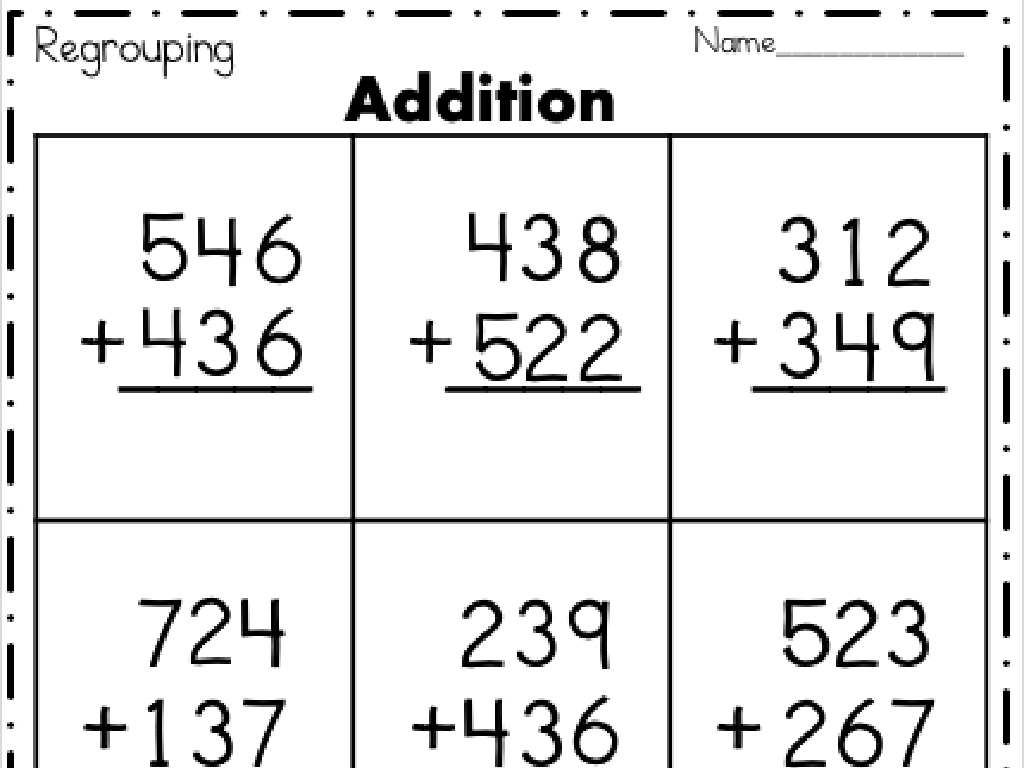Count Forward And Backward By Fives, Tens, And Hundreds
Subject: Math
Grade: Second grade
Topic: Skip-Counting And Number Patterns
Summary: This second-grade math presentation teaches skip-counting forward and backward by fives, tens, and hundreds to help students recognize number patterns and improve addition and subtraction skills. Through interactive activities like number line hopscotch and counting challenges, students practice sequencing, identify numerical patterns, and build a foundation for concepts like telling time and multiplication. Hands-on exercises make number sense fun and engaging, promoting fluency and confidence in early arithmetic.
Please LOG IN to download the presentation. Access is available to registered users only.
View More Content
Welcome to Skip-Counting!
– Learn to count in fun ways
– Count by fives, tens, and hundreds
– Practice with numbers like 5, 10, 15, 20…
– Discover patterns in numbers
– Find the sequence in numbers as they grow
– See how patterns help in math
– Patterns make addition and subtraction easier
|
This slide introduces second graders to the concept of skip-counting, an essential skill in understanding number patterns and building a foundation for more complex arithmetic. Start by engaging the students with the idea that counting can be fun and not just a rote activity. Demonstrate counting by fives, tens, and hundreds using visual aids or physical movements to make the learning process interactive. Highlight how recognizing patterns in numbers can simplify tasks like addition and subtraction, and provide a variety of examples to illustrate these patterns. Encourage the students to participate by counting aloud and using their fingers to represent the numbers as they count.
What is Skip-Counting?
– Skip-counting: Jumping numbers
– Imagine hopping on a number line
– Like skipping stones, but with numbers!
– Skip-count by fives and tens
– Try 0, 5, 10, 15, 20, then backwards!
– It helps count things quickly
– Use it to add or subtract easily
|
This slide introduces the concept of skip-counting to second graders, which is a fundamental skill in understanding number patterns and sequences. It’s important to explain that skip-counting is a method used to count numbers at a faster pace by ‘jumping’ over some of them. Use relatable analogies like hopping on a number line to make it more intuitive. Demonstrate skip-counting by fives and tens using a number line or with physical movements to engage the students. Emphasize how this technique is useful in everyday scenarios, such as quickly adding or subtracting items, or telling time. Encourage students to practice by counting aloud in class and at home.
Counting by Fives
– Starting with fives
– Count fingers on a hand
– Each hand has 5 fingers, a perfect start!
– Counting: 5, 10, 15, 20…
– Add 5 more for each step: 5+5=10, 10+5=15…
– Practice skip-counting by 5
– Try counting by fives with different starting numbers
|
This slide introduces students to the concept of skip-counting by fives. Begin by engaging them with something familiar – their own hands, which naturally represent the number five. This visual and physical representation helps them grasp the concept of counting by increments of five. As you demonstrate counting by fives, encourage the students to join in and count aloud together. Emphasize the pattern that emerges as they count. For practice, have students count by fives starting from different numbers, not just zero, to ensure they understand the pattern beyond the initial sequence. This activity can be turned into a fun game or song to make the learning process enjoyable.
Let’s Practice Counting by Fives!
– Counting by fives together
– Follow me: 5, 10, 15, 20, …
– Pattern: numbers end in 0 or 5
– Look! 5, 15, 25, 35, all end with 5 or 0
– Count by fives to 50 challenge
– Try it yourself: start from 5 and stop at 50!
– Understanding the number pattern
|
This slide is designed to engage second-grade students in a counting exercise that helps them understand and practice skip-counting by fives. Start by counting together as a class, emphasizing the audible pattern and rhythm. Highlight how each number in this sequence ends with either a 0 or a 5, which is a key observation for recognizing the pattern. Challenge the students to count by fives on their own, up to 50, to reinforce the concept. Encourage them to use their fingers or visual aids if needed. This activity will help solidify their understanding of number patterns and prepare them for more advanced skip-counting.
Counting by Tens
– Understanding counting by tens
– Count by tens to understand number patterns
– Ten equals two hands of fingers
– Each hand has 5 fingers, so two hands make 10
– Counting sequence: 10, 20, 30, 40…
– After 10 comes 20, then 30, and it keeps adding 10
– Practice counting by tens together
|
This slide is focused on teaching second graders how to count by tens, which is a fundamental skip-counting skill that helps with number sense and place value understanding. Start by explaining that ten is a special number in our number system, partly because we have ten fingers. Use visuals of hands to help students make the connection. Then, demonstrate the counting sequence by tens, emphasizing the pattern that each number ends with a zero. Engage the class by counting aloud together, and encourage them to use their fingers to represent each group of ten as they count. This kinesthetic approach will help solidify the concept. For homework, students can practice by listing items in groups of ten, like ’10 pencils, 20 erasers, 30 blocks’, to reinforce the pattern.
Let’s Practice Counting by Tens!
– Skip-counting by tens together
– We’ll count in jumps, like 10, 20, 30, and so on
– Notice the pattern in numbers
– Each number we say ends with a zero
– Count by tens to 100
– Let’s try: 10, 20, 30… can we reach 100?
– Practice makes perfect
|
This slide is designed to engage second-grade students in a fun and interactive counting activity. Start by explaining skip-counting and demonstrate counting by tens. Highlight the pattern that each number in this sequence ends with a zero, which makes it easier to remember. Encourage the students to join in and count aloud together up to 100. Use visual aids like number lines or charts if possible to reinforce the concept. The goal is to practice repeatedly to build confidence and fluency in skip-counting by tens. Remember to praise their efforts and progress to foster a positive learning environment.
Counting by Hundreds
– Understanding big number jumps
– Visualize 100 as a giant leap
– Picture each 100 as a big hop on the number line
– Practice counting: 100, 200, 300…
– Start at 100 and add 100 each time: 100, 200, 300, 400…
– Continue the pattern forward
– Can we count by hundreds up to 1000? Let’s try!
|
This slide introduces students to the concept of skip-counting by hundreds, which is a significant numerical increment for second graders. Emphasize the idea that counting by hundreds is like taking giant leaps on a number line, helping them visualize the distance between each hundred. Use a number line graphic in class to demonstrate these jumps. Encourage students to practice counting aloud by hundreds, starting from 100 and adding 100 each time to reinforce the pattern. Ask them to continue the sequence beyond what’s shown on the slide, aiming for a goal like 1000, to challenge their understanding and make the activity engaging.
Let’s Practice Counting by Hundreds!
– Counting by hundreds challenge
– Ready? Start at 100 and jump forward!
– Each jump adds a 100 dollar bill
– Imagine you’re collecting $100 with every jump.
– Count by hundreds to 1000
– 100, 200, 300… all the way to 1000!
|
This slide is designed to help students visualize counting by hundreds as a fun activity, similar to collecting money. By associating each jump with adding a $100 bill, students can relate to the concept of skip counting in a tangible way. Encourage them to count aloud together, starting at 100 and making ‘jumps’ in increments of 100 until they reach 1000. This exercise will reinforce their understanding of number patterns and help them recognize the concept of adding larger quantities. It’s also a stepping stone to understanding basic concepts of money and value. Make sure to praise their efforts and correct any mistakes gently to maintain their confidence.
The Power of Skip-Counting
– Skip-counting and time-telling
– Count by 5s to read minutes on a clock
– Eases addition and subtraction
– Add or subtract by 10s and 100s quickly
– Foundation for multiplication
– Understanding groups and multiples
– Practice makes perfect
|
Skip-counting is a critical skill in second-grade mathematics that aids in various everyday tasks and sets the groundwork for more advanced math concepts. By learning to count by fives, students can easily read minutes on a clock, which is essential for telling time. It also simplifies the process of adding and subtracting larger numbers, making calculations quicker and more efficient. Furthermore, skip-counting introduces students to the concept of multiplication by grouping numbers. Encourage students to practice skip-counting regularly to build fluency and confidence. Provide various examples and opportunities for students to apply skip-counting in different scenarios.
Class Activity: Number Line Hopscotch
– Play hopscotch with a math twist
– Hop by fives, tens, and hundreds
– Start at 0, hop to 5, 10, 15, and so on
– Partner up for skip-counting fun
– Cooperation makes learning fun
– Take turns and count aloud
– Practice makes perfect in counting
|
This interactive activity is designed to help second graders understand the concept of skip-counting in a physical and engaging way. Set up a number line on the floor using tape or chalk. Students will work in pairs to reinforce the concept of counting by intervals of fives, tens, and hundreds. One student will hop along the number line while the other offers encouragement and checks for accuracy. After each turn, partners should switch roles. This activity not only helps with mathematical understanding but also promotes teamwork and physical activity. Possible variations include counting backwards, starting from different numbers, or challenging students to reach a specific number using the least amount of hops.




